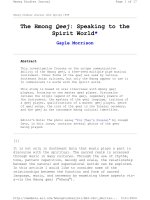Tài liệu Introduction to the Altera SOPC Builder Using Verilog Design ppt
Bạn đang xem bản rút gọn của tài liệu. Xem và tải ngay bản đầy đủ của tài liệu tại đây (872.71 KB, 19 trang )
Introduction to the Altera SOPC Builder
Using Verilog Design
This tutorial presents an introduction to Altera’s SOPC Builder software, which is used to implement a system
that uses the Nios II processor on an Altera FPGA device. The system development flow is illustrated by giving
step-by-step instructions for using the SOPC Builder in conjuction with the Quartus
R
II software to implement a
simple system.
The last step in the development process involves configuring the designed circuit in an actual FPGA device,
and running an application program. To show how this is done, it is assumed that the user has access to the Altera
DE2 Development and Education board connected to a computer that has Quartus II and Nios
R
II software
installed.
The screen captures in the tutorial were obtained using the Quartus II version 5.1; if other versions of the
software are used, some of the images may be slightly different.
Contents:
Nios II System
Altera’s SOPC Builder
Integration of the Nios II System into a Quartus II Project
Running the Application Program
1
Altera’s Nios II is a soft processor, defined in a hardware description language, which can be implemented
in Altera’s FPGA devices by using the Quartus
R
II CAD system. To implement a useful system it is necessary
to add other funcional units such as memories, input/output interfaces, timers, and communications interfaces.
To facilitate the implementation of such systems, it is useful to have computer-aided-design (CAD) software for
implementing a system-on-a-programmable-chip (SOPC). Altera’s SOPC Builder is the software needed for this
task.
This tutorial provides a basic introduction to Altera’s SOPC Builder, which will allow the reader to quickly
implement a simple Nios II system on the Altera DE2 board. For a fuller treatment of the SOPC Builder, the
reader can consult the Nios II Hardware Development Tutorial. A complete description of the SOPC Builder can
be found in the Quartus II Handbook Volume 4: SOPC Builder. These documents are available on the Altera web
site.
1 Nios II System
A Nios II system can be implemented on the DE2 board as shown in Figure 1.
On-chip
memory
interface
SDRAM
interface
Flash
memory
Parallel I/O
interface
Serial I/O
interface
SRAM
interface
SRAM
chip
SDRAM
chip
chip
Flash
memory
Avalon switch fabric
Nios II processor
JTAG UART
interface
USB-Blaster
interface
Host computer
lines
Parallel
I/O port
lines
Serial
I/O port
Cyclone II
FPGA chip
JTAG Debug
module
Figure 1. A Nios II system implemented on the DE2 board.
2
The Nios II processor and the interfaces needed to connect to other chips on the DE2 board are implemented
in the Cyclone II FPGA chip. These components are interconnected by means of the interconnection network
called the Avalon Switch Fabric. The memory blocks in the Cyclone II device can be used to provide an on-chip
memory for the Nios II processor. The SRAM, SDRAM and Flash memory chips on the DE2 board are accessed
through the appropriate interfaces. Parallel and serial input/output interfaces provide typical I/O ports used in
computer systems. A special JTAG UART interface is used to connect to the circuitry that provides a Universal
Serial Bus (USB) link to the host computer to which the DE2 board is connected. This circuitry and the associated
software is called the USB-Blaster. Another module, called the JTAG Debug module, is provided to allow the host
computer to control the Nios II system. It makes it possible to perform operations such as downloading programs
into memory, starting and stopping execution, setting breakpoints, and collecting real-time execution trace data.
Since all parts of the Nios II system implemented on the FPGA chip are defined by using a hardware descrip-
tion language, a knowledgeable user could write such code to implement any part of the system. This would be
an onnerous and time consuming task. Instead, one can use the SOPC Builder to implement a desired system
simply by choosing the required components and specifying the parameters needed to make each component fit
the overall requirements of the system. In this tutorial, we will illustrate the capability of the SOPC Builder by
designing a very simple system. The same approach is used to design large systems.
On-chip
memory
parallel input
interface
parallel output
interface
Avalon switch fabric
Nios II processor
JTAG UART
interface
USB-Blaster
interface
Host computer
Cyclone II
FPGA chip
SW7 SW0 LEDG7 LEDG0
Reset_n Clock
LEDs
JTAG Debug
module
Switches
Figure 2. A simple example of a Nios II system.
3
Our example system is given in Figure 2. The system realizes a trivial task. Eight toggle switches on the DE2
board, SW 7 − 0, are used to turn on or off the eight green LEDs, LEDG7 − 0. The switches are connected to the
Nios II system by means of a parallel I/O interface configured to act as an input port. The LEDs are driven by the
signals from another parallel I/O interface configured to act as an output port. To achieve the desired operation, the
eight-bit pattern corresponding to the state of the switches has to be sent to the output port to activate the LEDs.
This will be done by having the Nios II processor execute a program stored in the on-chip memory. Continuous
operation is required, such that as the switches are toggled the lights change accordingly.
We will use the SOPC Builder to design the hardware depicted in Figure 2. Next, we will assign the Cyclone II
pins to realize the connections between the parallel interfaces and the switches and LEDs which act as I/O devices.
Then, we will configure the FPGA to implement the designed system. Finally, we will use the software tool called
the Nios II Debug Client to assemble, download and execute a Nios II program that performs the desired task.
Doing this tutorial, the reader will learn about:
• Using the SOPC Builder to design a Nios II-based system
• Integrating the designed Nios II system into a Quartus II project
• Implementing the designed system on the DE2 board
• Running an application program on the Nios II processor
2 Altera’s SOPC Builder
The SOPC Builder is a tool used in conjuction with the Quartus II CAD software. It allows the user to easily
create a system based on the Nios II processor, by simply selecting the desired functional units and specifying
their parameters. To implement the system in Figure 2, we have to instantiate the following functional units:
• Nios II processor, which is referred to as a Central Processing Unit (CPU)
• On-chip memory, which consists of the memory blocks in the Cyclone II chip; we will specify a 4-Kbyte
memory arranged in 32-bit words
• Two parallel I/O interfaces
• JTAG UART interface for communication with the host computer
To define the desired system, start the Quartus II software and perform the following steps:
1. Create a new Quartus II project for your system. As shown in Figure 3, we stored our project in a directory
called sopc_builder_tutorial, and we assigned the name lights to both the project and its top-level design
entity. You can choose a different directory or project name, but be aware that the SOPC Builder software
does not permit the use of spaces in file names. For example, an attempt to use a directory name sopc
builder tutorial would lead to an error. In your project, choose the EP2C35F672C6 chip as the target device,
because this is the FPGA on the DE2 board.
2. Select Tools > SOPC Builder, which leads to the pop-up box in Figure 4. Enter nios_system as the system
name; this will be the name of the system that the SOPC Builder will generate. Choose Verilog as the target
HDL, in which the system module will be specified. Click OK to reach the window in Figure 5.
4
Figure 3. Create a new project.
Figure 4. Create a new Nios II system.
3. Figure 5 displays the System Contents tab of the SOPC Builder, which is used to add components to the
system and configure the selected components to meet the design requirements. The available components
are listed on the left side of the window. Before choosing our components, examine the area in the figure
labeled Target. A drop-down list is provided that allows some available Altera boards to be selected. It is
not necessary to select a board, and since the DE2 board is not included in the list leave the selection as
Unspecified board. Next, check the setting for the Device Family and ensure that Cyclone II is selected.
4. The Nios II processor runs under the control of a clock. For this tutorial we will make use of the 50-MHz
clock that is provided on the DE2 board. As shown in Figure 5, it is possible to specify the names and
frequency of clock signals in the SOPC Builder display. If not already included in this list, specify a clock
named clk with the source designated as External and the frequency set to 50.0 MHz.
5
Figure 5. The System Contents tab window.
5. Next, specify the processor as follows:
• On the left side of the window in Figure 5 select Avalon Components > Nios II Processor - Altera
Corporation and click Add, which leads to the window in Figure 6.
Figure 6. Create a Nios II processor.
6
• Choose Nios II/e which is the simplest version of the processor. Click Finish to return to the window
in Figure 5, which now shows the Nios II processor specified as indicated in Figure 7. There may be
some warnings or error messages displayed in the SOPC Builder Messages window (at the bottom of
the screen), because some parameters have not yet been specified. Ignore these messages as we will
provide the necessary data later. Observe also that a new tab called Nios II More “cpu_0” Settings
appears, which allows further configuration of the processor - we will not use it.
Figure 7. The defined processor.
6. To specify the on-chip memory perform the following:
• Select Avalon Components > Memory > On-Chip Memory (RAM or ROM) and click Add
• In the On-Chip Memory Configuration Wizard window, shown in Figure 8, set the memory width to
32 bits and the total memory size to 4 Kbytes
• Do not change the other default settings
• Click Finish, which returns to the System Contents tab as indicated in Figure 9
7









